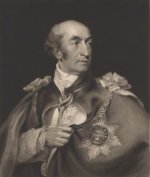| 1732-1812 [vars. Blacquière; vars. Blaquière, Blaquiere; Lord de Blaquiere, 1st Baron de Blacquiere]; b. London of Huguenot stock, being fifth son of Jean de Blaquiere who reached to England in 1685, and his wife Marie Elizabeth [née de Varennes; served in the 18th [later 17th] Dragoons, and promoted to Lieut.-Colonel; Secretary of Legation at the British Embassy in Paris under Lord Harcourt, 1771-72; became Irish Chief Sec. when Harcourt was appt. to Lord Lieutenancy of Ireland, 1772-77; entered Privy Council of Ireland, 1772; made Knight Companion of the Order of Bath, 1774; elected MP for Old Leighlin, 1773-83; advocated tax on absentees; Privy Councillor, 1774; |
| m. Eleanor, dg. of Robert Dodson, 1775, with whom four sons and three dgs.; MP for Enniskillen, 1783, and then for Carlingford., 1783-90; MP for Charleville from 1790 to 1798; MP for Newtownards, 1798-1800; served as Commissioner of the Paving Board in Dublin; created Baronet of Ardkill (Co. Londonderry), 1784; raised to the peerage as Baron de Blaquiere of Ardkill, 1800, for supporting the Union; elected MP for Rye, Sussex, 1801-02; elected Fellow of the Royal Society, 1803; d. at Bray, Aug. 1812, and bur. in St. Anne’s Churchyard, Brunswick [now Pearse St.], Dublin; succeeded by his eldest son John and his wife (d. Regent’s Park, London, 1833); |
| Blacquiere was instrumental in founding the Catholic Committee, with Lord Trimleston and others and became the model for Sir Ulick O’Shane in Maria Edgeworth’s Ormond; he was known as “Queerblack” in satirical playbills at the time of the Union; the bridge on the Royal Canal at Phibsborough was named after him (viz, Blacquiere Bridge); there is a portrait by Charles Turner and and engraving from same by John James Masquerier. [No ODNB.] |
|
[ top ]
Criticism
See Joan Tighe, ‘Sir John Blacquiere in Dublin’, in Dublin Hist. Rec., 24, 2 (1971), pp.3-14. [given in Eager]; also Roy Foster, Modern Ireland (London: Allen Lane 1988), p.229. There is a Wikipedia page - online.
Note: A. N. Jeffares, Anglo-Irish Literature (1982), remarks that Maria Edgeworth modelled Sir Ulick in Ormond (1817) on Sir John de Blacquiere (p.86).
| The Foundling Hospital |
| (Speech in the Irish House of Commons, 1790): |
| ‘The number of infants received in 1789 was 2,180, and of that number 2,087 were dead or unaccounted for. In ten years 19,367 children had been entered upon the books, and almost 17,000 were dead or missing. The wretched little ones were sent up from all parts of Ireland, ten or twelve of them thrown together in a kish or basket, forwarded in a low-backed car, and so bruised and crushed and shaken at their journey’s end that half of them were taken out dead, and were flung into a dung-heap.’ (Quoted in James Connolly, The Reconquest of Ireland [Chap. 7], rep. with Labour in Ireland, 1917, p.247.) |
Note: Connolly remarks, ‘That last touch “flung into the dung-heap” is characteristic of the thought and practices of the ruling class of the time. The children were only children of the poor, and the poor - whether Protestant or Catholic - were only esteemed, perhaps are only esteemed to-day, by the rich, as in Kropotkin’s words, “mere dung to manure the pasture lands of the rich expropriator”’. |
Notes
Blacquiere Bridge: the bridge named after him on the Royal Canal at Phibsborough, Dublin, is erroneously cited as Blancière Bridge in Thomas Connolly, ed., Scribbledehobble (Northwestern UP 1961), being the Ur-Notebook of James Joyce’s Finnegans Wake.
[ top ]
